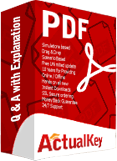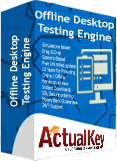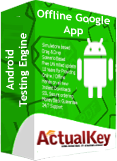Actualkey Prepration Latest Databricks-Generative-AI-Engineer-Associate : Databricks Certified Generative AI Engineer Associate Questions and Answers PDF's, Verified Answers via Experts - Pass Your Exam For Sure and instant Downloads - "Money Back Guarantee".
| Vendor | Databricks |
| Certification | Databricks Generative AI Engineer Associate |
| Exam Code | Databricks-Generative-AI-Engineer-Associate |
| Title | Databricks Certified Generative AI Engineer Associate |
| No Of Questions | 45 |
| Last Updated | November 8,2024 |
| Product Type | Q & A with Explanation |
| Bundel Pack Included | PDF + Offline / Andriod Testing Engine and Simulator |




Databricks Certified Generative AI Engineer Associate
The Databricks Certified Generative AI Engineer Associate certification exam assesses an individual’s ability to design and implement LLM-enabled solutions using Databricks. This includes problem decomposition to break down complex requirements into manageable tasks as well as choosing appropriate models, tools and approaches from the current generative AI landscape for developing comprehensive solutions. It also assesses Databricks-specific tools such as Vector Search for semantic similarity searches, Model Serving for deploying models and solutions, MLflow for managing a solution lifecycle, and Unity Catalog for data governance. Individuals who pass this exam can be expected to build and deploy performant RAG applications and LLM chains that take full advantage of Databricks and its toolset.
The exam covers:
Design Applications – 14%
Data Preparation – 14%
Application Development – 30%
Assembling and Deploying Apps – 22%
Governance – 8%
Evaluation and Monitoring – 12%
Assessment Details
Type: Proctored certification
Total number of questions: 45
Time limit: 90 minutes
Registration fee:
Question types: Multiple choice
Test aides: None allowed
Languages: English, ???, Português BR, ???
Delivery method: Online proctored
Prerequisites: None, but related training highly recommended
Recommended experience: 6+ months of hands-on experience performing the generative AI solutions tasks outlined in the exam guide
Validity period: 2 years
Recertification: Recertification is required every two years to maintain your certified status. To recertify, you must take the current version of the exam. Please review the “Getting Ready for the Exam” section below to prepare for your recertification exam.
Unscored content: Exams may include unscored items to gather statistical information for future use. These items are not identified on the form and do not impact your score. Additional time is factored into the exam to account for this content.
Sample Question and Answers
QUESTION 1
A Generative Al Engineer has created a RAG application to look up answers to questions about a
series of fantasy novels that are being asked on the authors web forum. The fantasy novel texts are
chunked and embedded into a vector store with metadata (page number, chapter number, book
title), retrieved with the users query, and provided to an LLM for response generation. The
Generative AI Engineer used their intuition to pick the chunking strategy and associated
configurations but now wants to more methodically choose the best values.
Which TWO strategies should the Generative AI Engineer take to optimize their chunking strategy
and parameters? (Choose two.)
A. Change embedding models and compare performance.
B. Add a classifier for user queries that predicts which book will best contain the answer. Use this to filter retrieval.
C. Choose an appropriate evaluation metric (such as recall or NDCG) and experiment with changes in
the chunking strategy, such as splitting chunks by paragraphs or chapters.
Choose the strategy that gives the best performance metric.
D. Pass known questions and best answers to an LLM and instruct the LLM to provide the best token
count. Use a summary statistic (mean, median, etc.) of the best token counts to choose chunk size.
E. Create an LLM-as-a-judge metric to evaluate how well previous questions are answered by the
most appropriate chunk. Optimize the chunking parameters based upon the values of the metric.
Answer: C, E
Explanation:
To optimize a chunking strategy for a Retrieval-Augmented Generation (RAG) application, the
Generative AI Engineer needs a structured approach to evaluating the chunking strategy, ensuring
that the chosen configuration retrieves the most relevant information and leads to accurate and
coherent LLM responses. Here's why C and E are the correct strategies:
Strategy C: Evaluation Metrics (Recall, NDCG)
Define an evaluation metric: Common evaluation metrics such as recall, precision, or NDCG
(Normalized Discounted Cumulative Gain) measure how well the retrieved chunks match the user's
query and the expected response.
Recall measures the proportion of relevant information retrieved.
NDCG is often used when you want to account for both the relevance of retrieved chunks and the
ranking or order in which they are retrieved.
Experiment with chunking strategies: Adjusting chunking strategies based on text structure (e.g.,
splitting by paragraph, chapter, or a fixed number of tokens) allows the engineer to experiment with
various ways of slicing the text. Some chunks may better align with the user's query than others.
Evaluate performance: By using recall or NDCG, the engineer can methodically test various chunking
strategies to identify which one yields the highest performance. This ensures that the chunking
method provides the most relevant information when embedding and retrieving data from the vector store.
Strategy E: LLM-as-a-Judge Metric
Use the LLM as an evaluator: After retrieving chunks, the LLM can be used to evaluate the quality of
answers based on the chunks provided. This could be framed as a "judge" function, where the LLM
compares how well a given chunk answers previous user queries.
Optimize based on the LLM's judgment: By having the LLM assess previous answers and rate their
relevance and accuracy, the engineer can collect feedback on how well different chunking
configurations perform in real-world scenarios.
This metric could be a qualitative judgment on how closely the retrieved information matches the user's intent.
Tune chunking parameters: Based on the LLM's judgment, the engineer can adjust the chunk size or
structure to better align with the LLM's responses, optimizing retrieval for future queries.
By combining these two approaches, the engineer ensures that the chunking strategy is
systematically evaluated using both quantitative (recall/NDCG) and qualitative (LLM judgment)
methods. This balanced optimization process results in improved retrieval relevance and,
consequently, better response generation by the LLM.
QUESTION 2
A Generative AI Engineer is designing a RAG application for answering user questions on technical
regulations as they learn a new sport.
What are the steps needed to build this RAG application and deploy it?
A. Ingest documents from a source “> Index the documents and saves to Vector Search “> User
submits queries against an LLM “> LLM retrieves relevant documents “> Evaluate model “> LLM
generates a response “> Deploy it using Model Serving
B. Ingest documents from a source “> Index the documents and save to Vector Search “> User
submits queries against an LLM “> LLM retrieves relevant documents “> LLM generates a response ->
Evaluate model “> Deploy it using Model Serving
C. Ingest documents from a source “> Index the documents and save to Vector Search “> Evaluate
model “> Deploy it using Model Serving
D. User submits queries against an LLM “> Ingest documents from a source “> Index the documents
and save to Vector Search “> LLM retrieves relevant documents “> LLM generates a response “>
Evaluate model “> Deploy it using Model Serving
Answer: B
Explanation:
The Generative AI Engineer needs to follow a methodical pipeline to build and deploy a Retrieval-
Augmented Generation (RAG) application. The steps outlined in option B accurately reflect this process:
Ingest documents from a source: This is the first step, where the engineer collects documents (e.g.,
technical regulations) that will be used for retrieval when the application answers user questions.
Index the documents and save to Vector Search: Once the documents are ingested, they need to be
embedded using a technique like embeddings (e.g., with a pre-trained model like BERT) and stored
in a vector database (such as Pinecone or FAISS). This enables fast retrieval based on user queries.
User submits queries against an LLM: Users interact with the application by submitting their queries.
These queries will be passed to the LLM.
LLM retrieves relevant documents: The LLM works with the vector store to retrieve the most relevant
documents based on their vector representations.
LLM generates a response: Using the retrieved documents, the LLM generates a response that is
tailored to the user's question.
Evaluate model: After generating responses, the system must be evaluated to ensure the retrieved
documents are relevant and the generated response is accurate. Metrics such as accuracy, relevance,
and user satisfaction can be used for evaluation.
Deploy it using Model Serving: Once the RAG pipeline is ready and evaluated, it is deployed using a
model-serving platform such as Databricks Model Serving. This enables real-time inference and
response generation for users.
By following these steps, the Generative AI Engineer ensures that the RAG application is both
efficient and effective for the task of answering technical regulation questions.
QUESTION 3
A Generative AI Engineer just deployed an LLM application at a digital marketing company that assists with answering customer service inquiries.
Which metric should they monitor for their customer service LLM application in production?
A. Number of customer inquiries processed per unit of time
B. Energy usage per query
C. Final perplexity scores for the training of the model
D. HuggingFace Leaderboard values for the base LLM
Answer: A
Explanation:
When deploying an LLM application for customer service inquiries, the primary focus is on measuring
the operational efficiency and quality of the responses. Here's why A is the correct metric:
Number of customer inquiries processed per unit of time: This metric tracks the throughput of the
customer service system, reflecting how many customer inquiries the LLM application can handle in
a given time period (e.g., per minute or hour). High throughput is crucial in customer service
applications where quick response times are essential to user satisfaction and business efficiency.
Real-time performance monitoring: Monitoring the number of queries processed is an important
part of ensuring that the model is performing well under load, especially during peak traffic times. It
also helps ensure the system scales properly to meet demand.
Why other options are not ideal:
B . Energy usage per query: While energy efficiency is a consideration, it is not the primary concern
for a customer-facing application where user experience (i.e., fast and accurate responses) is critical.
C . Final perplexity scores for the training of the model: Perplexity is a metric for model training, but
it doesn't reflect the real-time operational performance of an LLM in production.
D . HuggingFace Leaderboard values for the base LLM: The HuggingFace Leaderboard is more
relevant during model selection and benchmarking. However, it is not a direct measure of the
model's performance in a specific customer service application in production.
Focusing on throughput (inquiries processed per unit time) ensures that the LLM application is
meeting business needs for fast and efficient customer service responses.
QUESTION 4
A Generative AI Engineer is building a Generative AI system that suggests the best matched
employee team member to newly scoped projects. The team member is selected from a very large team.
The match should be based upon project date availability and how well their employee profile
matches the project scope. Both the employee profile and project scope are unstructured text.
How should the Generative Al Engineer architect their system?
A. Create a tool for finding available team members given project dates. Embed all project scopes
into a vector store, perform a retrieval using team member profiles to find the best team member.
B. Create a tool for finding team member availability given project dates, and another tool that uses
an LLM to extract keywords from project scopes. Iterate through available team members profiles
and perform keyword matching to find the best available team member.
C. Create a tool to find available team members given project dates. Create a second tool that can
calculate a similarity score for a combination of team member profile and the project scope. Iterate
through the team members and rank by best score to select a team member.
D. Create a tool for finding available team members given project dates. Embed team profiles into a
vector store and use the project scope and filtering to perform retrieval to find the available best
matched team members.
Answer: D
Explanation:
Problem Context: The problem involves matching team members to new projects based on two main factors:
Availability: Ensure the team members are available during the project dates.
Profile-Project Match: Use the employee profiles (unstructured text) to find the best match for a
projects scope (also unstructured text).
The two main inputs are the employee profiles and project scopes, both of which are unstructured.
This means traditional rule-based systems (e.g., simple keyword matching) would be inefficient,
especially when working with large datasets.
Explanation of Options: Let's break down the provided options to understand why D is the most optimal answer.
Option A suggests embedding project scopes into a vector store and then performing retrieval using
team member profiles. While embedding project scopes into a vector store is a valid technique, it
skips an important detail: the focus should primarily be on embedding employee profiles because
we're matching the profiles to a new project, not the other way around.
Option B involves using a large language model (LLM) to extract keywords from the project scope and
perform keyword matching on employee profiles. While LLMs can help with keyword extraction, this
approach is too simplistic and doesnt leverage advanced retrieval techniques like vector
embeddings, which can handle the nuanced and rich semantics of unstructured data. This approach
may miss out on subtle but important similarities.
Option C suggests calculating a similarity score between each team member's profile and project
scope. While this is a good idea, it doesnt specify how to handle the unstructured nature of data
efficiently. Iterating through each members profile individually could be computationally expensive
in large teams. It also lacks the mention of using a vector store or an efficient retrieval mechanism.
Option D is the correct approach. Heres why:
Embedding team profiles into a vector store: Using a vector store allows for efficient similarity
searches on unstructured data. Embedding the team member profiles into vectors captures their
semantics in a way that is far more flexible than keyword-based matching.
Using project scope for retrieval: Instead of matching keywords, this approach suggests using vector
embeddings and similarity search algorithms (e.g., cosine similarity) to find the team members
whose profiles most closely align with the project scope.
Filtering based on availability: Once the best-matched candidates are retrieved based on profile
similarity, filtering them by availability ensures that the system provides a practically useful result.
This method efficiently handles large-scale datasets by leveraging vector embeddings and similarity
search techniques, both of which are fundamental tools in Generative AI engineering for handling
unstructured text.
Technical References:
Vector embeddings: In this approach, the unstructured text (employee profiles and project scopes) is
converted into high-dimensional vectors using pretrained models (e.g., BERT, Sentence-BERT, or
custom embeddings). These embeddings capture the semantic meaning of the text, making it easier
to perform similarity-based retrieval.
Vector stores: Solutions like FAISS or Milvus allow storing and retrieving large numbers of vector
embeddings quickly. This is critical when working with large teams where querying through
individual profiles sequentially would be inefficient.
LLM Integration: Large language models can assist in generating embeddings for both employee
profiles and project scopes. They can also assist in fine-tuning similarity measures, ensuring that the
retrieval system captures the nuances of the text data.
Filtering: After retrieving the most similar profiles based on the project scope, filtering based on
availability ensures that only team members who are free for the project are considered.
This system is scalable, efficient, and makes use of the latest techniques in Generative AI, such as
vector embeddings and semantic search.
QUESTION 5
A Generative AI Engineer is designing an LLM-powered live sports commentary platform. The
platform provides real-time updates and LLM-generated analyses for any users who would like to
have live summaries, rather than reading a series of potentially outdated news articles.
Which tool below will give the platform access to real-time data for generating game analyses based on the latest game scores?
A. DatabrickslQ
B. Foundation Model APIs
C. Feature Serving
D. AutoML
Answer: C
Explanation:
Problem Context: The engineer is developing an LLM-powered live sports commentary platform that
needs to provide real-time updates and analyses based on the latest game scores. The critical
requirement here is the capability to access and integrate real-time data efficiently with the platform
for immediate analysis and reporting.
Explanation of Options:
Option A: DatabricksIQ: While DatabricksIQ offers integration and data processing capabilities, it is
more aligned with data analytics rather than real-time feature serving, which is crucial for immediate
updates necessary in a live sports commentary context.
Option B: Foundation Model APIs: These APIs facilitate interactions with pre-trained models and
could be part of the solution, but on their own, they do not provide mechanisms to access real-time game scores.
Option C: Feature Serving: This is the correct answer as feature serving specifically refers to the realtime
provision of data (features) to models for prediction. This would be essential for an LLM that
generates analyses based on live game data, ensuring that the commentary is current and based on
the latest events in the sport.
Option D: AutoML: This tool automates the process of applying machine learning models to realworld
problems, but it does not directly provide real-time data access, which is a critical requirement
for the platform.
Thus, Option C (Feature Serving) is the most suitable tool for the platform as it directly supports the
real-time data needs of an LLM-powered sports commentary system, ensuring that the analyses and
updates are based on the latest available information.
Copyright © 2009 - 2025 Actualkey. All rights reserved.